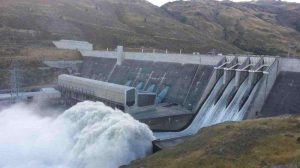
Recently published research from Victoria University of Wellington and GNS Science has provided a unique insight into the hydrological effects of earthquakes in New Zealand.
Led by Victoria alumnus Grant O’Brien for his Master’s thesis, the research highlights the impact earthquakes can have on groundwater systems hundreds of kilometres away.
The research was based in the Cromwell Gorge and made use of a large hydrological dataset that has recorded groundwater responses to a series of earthquakes that have occurred in the region over the past few decades.
This is the first time that the landslide monitoring data set, provided by Contact Energy Clyde Dam, has been analysed to determine the effects of earthquake shaking on sensitive groundwater systems.
“The data set used in this study is of rare international size and scope and as far as we can tell is unique in spanning multiple sites and multiple earthquakes over such a long period of time (23 years). This means we have been able to construct a detailed picture of the behaviour of different groundwater systems in response to earthquakes, ongoing engineering activities and other factors such as intense rainfall,” says Mr O’Brien.
The study was supervised by Dr Simon Cox from GNS Science and Professor John Townend from Victoria’s School of Geography, Environment and Earth Sciences, and funded by the Earthquake Commission and the Marsden Fund managed by the Royal Society of New Zealand.
The study, published in the Journal of Geophysical Research, shows the sensitivity of groundwater systems to seismic waves at distances well beyond areas of obvious shaking and surface ground damage.
“Our research showed that groundwater systems within seven large landslides in the Cromwell Gorge are surprisingly susceptible to seismic shaking, with the pressures and flow rates responding systematically to large earthquakes at distances of several hundred kilometres,” says Mr O’Brien.
Differences in the type of earthquake shaking—in particular, the duration, amount and frequency of shaking—result in different groundwater responses. The Cromwell Gorge data show that these changes are triggered by stresses associated with the passage of the seismic waves from the earthquake.
“We found that long-duration earthquakes producing seismic waves with a broad range frequencies cause larger groundwater responses that die away more quickly than those produced by short, sharp earthquakes.”
While scientists have yet to examine the effect of the 2016 magnitude 7.8 Kaikoura earthquake on the groundwater systems at Cromwell Gorge, Mr O’Brien expects the monitoring equipment will have recorded a response.
This finding highlights how components of New Zealand’s engineering infrastructure that are dependent on groundwater, such as dams or irrigation schemes, are affected by earthquakes happening in other parts of the country.
“Although the groundwater changes did not affect the motion of Cromwell Gorge landslides, which are engineered to stop movement, the monitoring by Contact Energy provides an incredible record for application elsewhere.
“The different ways groundwater systems respond to the type of earthquake shaking we have observed is critical to understanding how landslides evolve in both the short and long term.”
Reference:
Grant A. O’Brien et al. Spatially and temporally systematic hydrologic changes within large geoengineered landslides, Cromwell Gorge, New Zealand, induced by multiple regional earthquakes, Journal of Geophysical Research: Solid Earth (2016). DOI: 10.1002/2016JB013418
Note: The above post is reprinted from materials provided by Victoria University.










